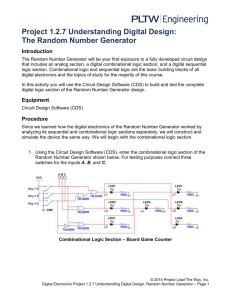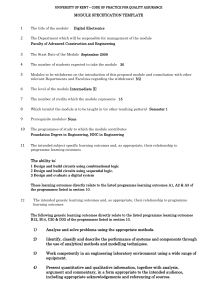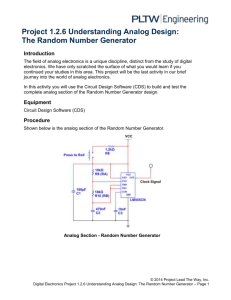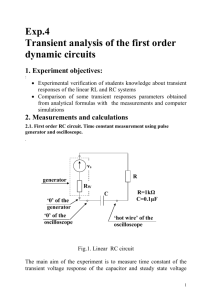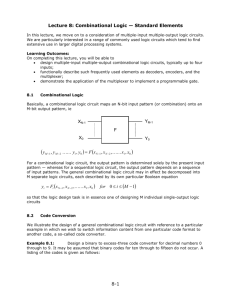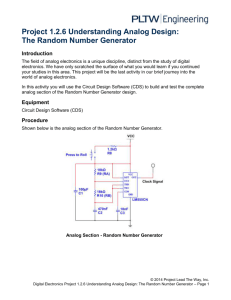File
advertisement
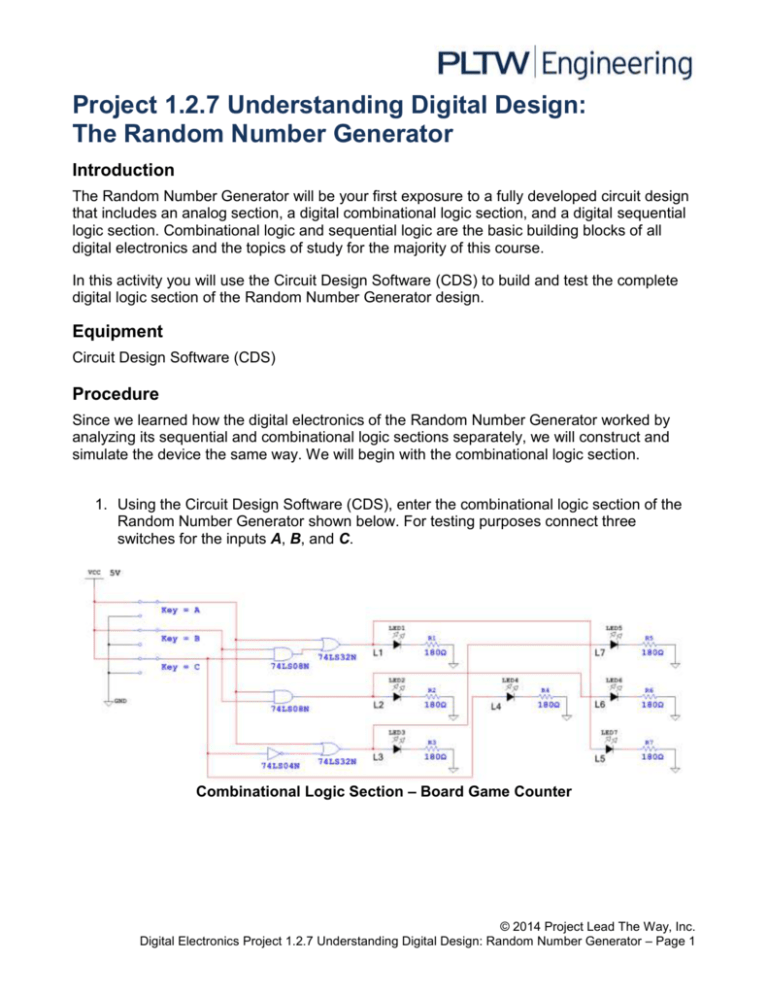
Project 1.2.7 Understanding Digital Design: The Random Number Generator Introduction The Random Number Generator will be your first exposure to a fully developed circuit design that includes an analog section, a digital combinational logic section, and a digital sequential logic section. Combinational logic and sequential logic are the basic building blocks of all digital electronics and the topics of study for the majority of this course. In this activity you will use the Circuit Design Software (CDS) to build and test the complete digital logic section of the Random Number Generator design. Equipment Circuit Design Software (CDS) Procedure Since we learned how the digital electronics of the Random Number Generator worked by analyzing its sequential and combinational logic sections separately, we will construct and simulate the device the same way. We will begin with the combinational logic section. 1. Using the Circuit Design Software (CDS), enter the combinational logic section of the Random Number Generator shown below. For testing purposes connect three switches for the inputs A, B, and C. Combinational Logic Section – Board Game Counter © 2014 Project Lead The Way, Inc. Digital Electronics Project 1.2.7 Understanding Digital Design: Random Number Generator – Page 1 a. Start the simulation. b. Toggle the switches and complete the truth table shown below. A B C L1 L2 L3 L4 L5 L6 L7 0 0 0 0 0 1 0 1 0 0 0 0 1 0 0 0 1 0 0 0 0 1 0 0 0 1 0 1 0 0 0 1 1 1 0 0 1 0 0 1 1 0 0 1 0 1 0 1 0 1 1 0 1 1 0 1 1 1 0 1 1 1 0 1 1 1 0 1 1 1 1 1 1 1 1 1 1 1 1 1 c. Did the outputs for the inputs 001 thru 110 display what was expected?YES If they didn’t, check your circuit to make sure that it was built correctly. Make any necessary corrections and repeat steps (a) and (b). d. Did the outputs for the inputs 000 and 111 make sense? No Does it matter? No 2. Now that the combinational logic section is working, let’s construct and simulate the sequential logic section. Using the Circuit Design Software (CDS), enter the sequential logic section of the Random Number Generator shown below. For the initial analysis, we will use a switch to generate the signal CLOCK. © 2014 Project Lead The Way, Inc. Digital Electronics Project 1.2.7 Understanding Digital Design: Random Number Generator – Page 2 X1 X2 2.5 V X3 2.5 V 2.5 V VCC 5V 4 10 U1A ~1PR VCC 2 4 U1B ~2PR 1Q 5 12 ~1Q 6 11 1D U2A ~1PR 2Q 9 2 ~2Q 8 3 2D 1Q 5 ~1Q 6 1D 5V S1 3 1CLK 2CLK ~1CLR 1 ~2CLR 74LS74N 13 1CLK ~1CLR 74LS74N 1 74LS74N Key = Space GND U3A U4A 74LS04N 74LS08N U4B 74LS08N Sequential Logic Section – Random Number Generator Start the simulation. a) Cycle the input CLOCK several times until the initial value is 001. Cycle the input CLOCK and record the value of the outputs A, B, and C in the table shown below. (Remember 1 Cycle = 2 Toggles of the switch) CLOCK A B C Initial Values 0 0 1 1st Cycle 0 1 0 2nd Cycle 0 1 1 3rd Cycle 1 0 0 4th Cycle 1 0 1 5th Cycle 1 1 0 6st Cycle 0 0 1 7th Cycle 0 1 0 b) Is the counter counting as expected (see below)? YESIf not, check your circuit to make sure that it was built correctly. Make any necessary corrections and repeat steps (a) and (b). © 2014 Project Lead The Way, Inc. Digital Electronics Project 1.2.7 Understanding Digital Design: Random Number Generator – Page 3 c) Modify the circuit by replacing the input switch with a CLOCK_VOLTAGE set to 5 volts, 50% duty cycle @ 50 Hz (see below). The CLOCK_VOLTAGE will continuously toggle the input, causing the output to repeatedly cycle through the count 001 to 110. Sequential Logic Section – Random Number Generator d) Start the simulation. e) Observe the outputs A, B, and C. They should be cycling through the following pattern: f) Is the counter counting as expected? YESIf not, check your circuit to make sure that it was built correctly. Make any necessary corrections and repeat steps (e) and (f). 3. Finally, let’s connect the combinational and sequential logic sections together to complete the Random Number Generator. a) Using the combinational logic and sequential logic sections created in steps (1) and (2) enter the circuit shown below into the Circuit Design Software (CDS). © 2014 Project Lead The Way, Inc. Digital Electronics Project 1.2.7 Understanding Digital Design: Random Number Generator – Page 4 X1 X2 2.5 V X3 2.5 V 2.5 V VCC 5V 4 10 U1A ~1PR 2 V1 3 1CLK 5 12 ~1Q 6 11 ~1CLR 50 Hz 5V 1 4 U1B ~2PR 1Q 1D 2CLK 9 2 ~2Q 8 3 1D 1Q 1CLK ~2CLR ~1Q 5 6 ~1CLR 13 74LS74N U2A ~1PR 2Q 2D 1 74LS74N GND 74LS74N U3A U4A 74LS04N 74LS08N U4B 74LS08N U5 U10 R3 U8 U14 180Ω 74LS32N R5 180Ω 74LS08N GND GND U11 U15 R2 U7 R6 U13 180Ω 74LS08N 180Ω R4 GND 180Ω GND U16 U9 74LS04N U6 74LS32N R7 U12 180Ω R1 180Ω GND GND GND Combinational & Sequential Logic Section – Random Number Generator © 2014 Project Lead The Way, Inc. Digital Electronics Project 1.2.7 Understanding Digital Design: Random Number Generator – Page 5 b) Start the simulation. c) Observe the outputs L1, L2, L3, L4, L5, L6, and L7. They should be cycling through the following pattern: d) Are the outputs working as expected? YESIf they are not, check your circuit to make sure that it was built correctly. Make any necessary corrections and repeat steps (b) and (c). Conclusion 1. The combinational logic used in the Random Number Generator was AOI logic. What are three gates that are used to implement AOI logic? Not Gate And Gate Or Gate 2. On the 74LS74 D flip-flop, the CLK input has a small triangle. The PR (preset) and CLR (clear) inputs have a circle. What do these symbols mean? Triangle means input and circles mean output 3. What is the primary characteristic that differentiates combinational and sequential logic? Sequential Logic has a state while combinational logic does not © 2014 Project Lead The Way, Inc. Digital Electronics Project 1.2.7 Understanding Digital Design: Random Number Generator – Page 6
